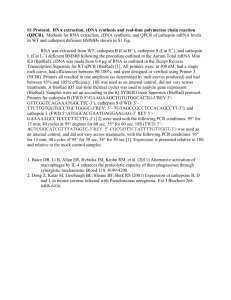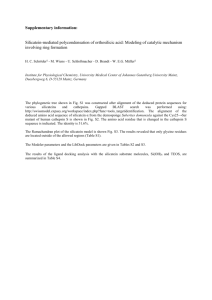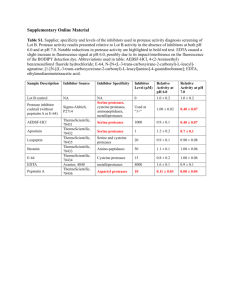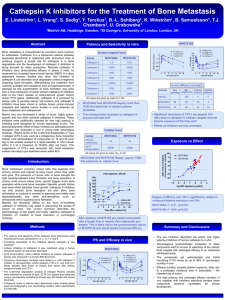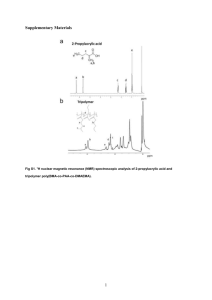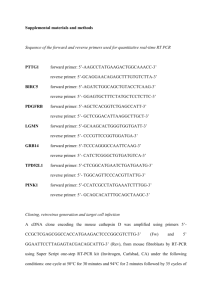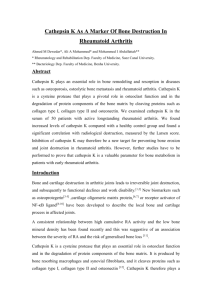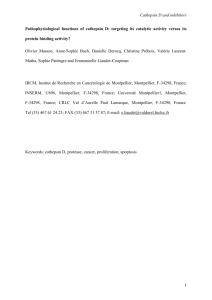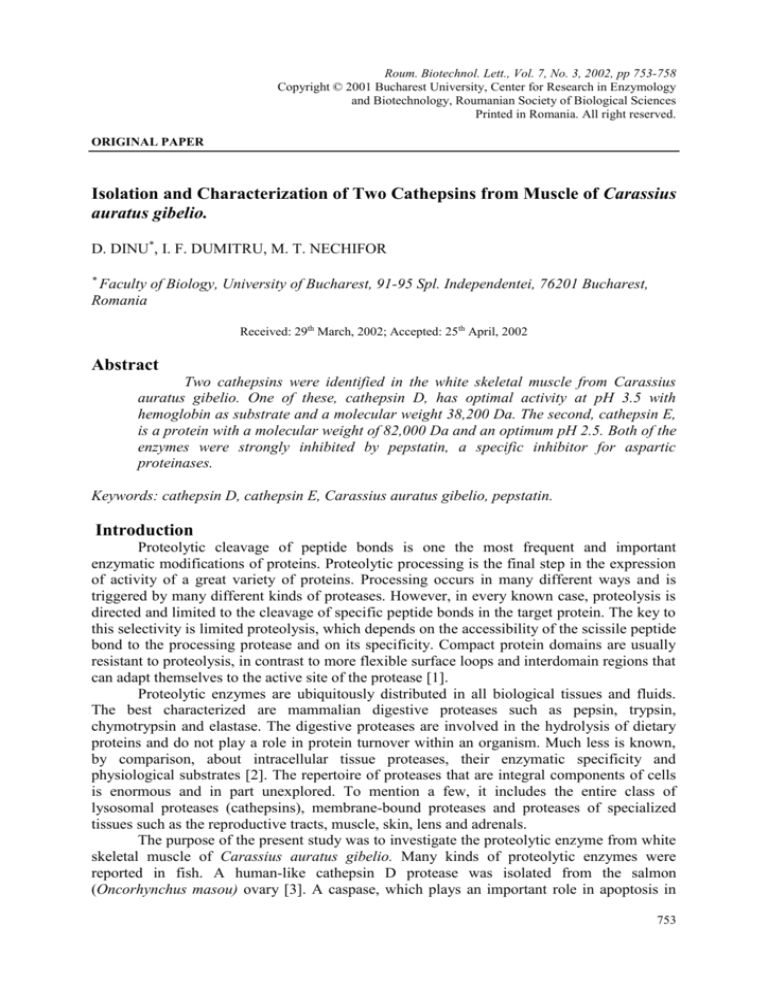
Roum. Biotechnol. Lett., Vol. 7, No. 3, 2002, pp 753-758
Copyright © 2001 Bucharest University, Center for Research in Enzymology
and Biotechnology, Roumanian Society of Biological Sciences
Printed in Romania. All right reserved.
ORIGINAL PAPER
Isolation and Characterization of Two Cathepsins from Muscle of Carassius
auratus gibelio.
D. DINU*, I. F. DUMITRU, M. T. NECHIFOR
*
Faculty of Biology, University of Bucharest, 91-95 Spl. Independentei, 76201 Bucharest,
Romania
Received: 29th March, 2002; Accepted: 25th April, 2002
Abstract
Two cathepsins were identified in the white skeletal muscle from Carassius
auratus gibelio. One of these, cathepsin D, has optimal activity at pH 3.5 with
hemoglobin as substrate and a molecular weight 38,200 Da. The second, cathepsin E,
is a protein with a molecular weight of 82,000 Da and an optimum pH 2.5. Both of the
enzymes were strongly inhibited by pepstatin, a specific inhibitor for aspartic
proteinases.
Keywords: cathepsin D, cathepsin E, Carassius auratus gibelio, pepstatin.
Introduction
Proteolytic cleavage of peptide bonds is one the most frequent and important
enzymatic modifications of proteins. Proteolytic processing is the final step in the expression
of activity of a great variety of proteins. Processing occurs in many different ways and is
triggered by many different kinds of proteases. However, in every known case, proteolysis is
directed and limited to the cleavage of specific peptide bonds in the target protein. The key to
this selectivity is limited proteolysis, which depends on the accessibility of the scissile peptide
bond to the processing protease and on its specificity. Compact protein domains are usually
resistant to proteolysis, in contrast to more flexible surface loops and interdomain regions that
can adapt themselves to the active site of the protease [1].
Proteolytic enzymes are ubiquitously distributed in all biological tissues and fluids.
The best characterized are mammalian digestive proteases such as pepsin, trypsin,
chymotrypsin and elastase. The digestive proteases are involved in the hydrolysis of dietary
proteins and do not play a role in protein turnover within an organism. Much less is known,
by comparison, about intracellular tissue proteases, their enzymatic specificity and
physiological substrates [2]. The repertoire of proteases that are integral components of cells
is enormous and in part unexplored. To mention a few, it includes the entire class of
lysosomal proteases (cathepsins), membrane-bound proteases and proteases of specialized
tissues such as the reproductive tracts, muscle, skin, lens and adrenals.
The purpose of the present study was to investigate the proteolytic enzyme from white
skeletal muscle of Carassius auratus gibelio. Many kinds of proteolytic enzymes were
reported in fish. A human-like cathepsin D protease was isolated from the salmon
(Oncorhynchus masou) ovary [3]. A caspase, which plays an important role in apoptosis in
753
D. DINU, I. F. DUMITRU, M. T. NECHIFOR
fish cells and zebrafish (Danio rerio) embryo, was reported [4]. From chum salmon
(Oncorhynchus Keta), an anionic trypsin acting on p- aminophenyl ester, was isolated [5]. In
rainbow trout matrix was detected a metalloproteinase capable of degrading type I collagen
[6].
Materials and Methods
Enzyme’s extraction
After the fish killed, the white skeletal muscle was quickly dissected and rinsed with
cold saline solution to remove blood. The tissue was suspended in demineralised water and
was disrupted with a Polytron homogenizer at 0-4oC. The disrupted cells were submitted at a
subcellular fractionation by differential centrifugation. In this procedure the homogenate was
centrifuged at 600 g for 10 minutes, than the supernatant obtained was centrifuged for 10
minutes at 10,000 g. The pellets were suspended in 0,1 M TRIS-HCl buffer, pH 7.4 and
centrifuged at 4,000 g. The clear supernatant obtained continents mainly proteins from
mitochondria and lysosomes and was utilized for investigation.
Assay of proteolytic activity
The proteolytic activity (cathepsin activity) was assayed according to Barret [7], using
acid-denatured hemoglobin as a substrate. A 8% hemoglobin solution was diluted about 3fold with distilled water, then acidified to pH 2.0 with 1 N HCl, and the final concentration of
hemoglobin was brought to 2% with distilled water. One milliliter of the substrate solution is
incubated with an appropriate amount of enzyme solution at 370C. The reaction is stopped by
addition of 2 ml of 5% trichloroacetic acid. The mixture was filtered and the soluble reaction
products were treated with Folin reagent and measured at 750nm.
Units of activity
There is no international agreement about units obtained by the hemoglobin-digestion
method. Some investigators, including Anson and Mirsky [8] used the amount of tyrosineequivalent in trichloroacetic acid-soluble peptide. In the current study, one unit of proteolytic
activity (U) was defined by the amount of enzyme will remove 1mol of tyrosine in a minute
from the acid-denatured hemoglobin.
Determination of protein
Protein concentration was determined using the Bradford method [9], with bovine
serum albumin as standard, and, during the course of enzyme purification, by measurement of
A280.
Testing of potential inhibitors
Portions of the enzyme solution were mixed with potential inhibitors and incubated for
30 minutes at 370C. Mixtures were then incubated with acid-denatured hemoglobin. Reagents
blanks were also run for each potential inhibitor. The percentage inhibition was determined
by comparing the activities with those measured for positive controls that contained no
inhibitor.
Results and Discussions
The crude extract of white muscle of Carassius auratus gibelio was fractionated with
acetone. The 40 – 70% acetone precipitate was collected by centrifugation at 15,000 g for 15
minutes at –50C. This was redissolved in 9% NaCl and applied on a Bio-Gel P-100 column
(1.6 x 72 cm) preequilibrated with the same solution. The column was run at 10 ml/h with a
solution 9% of NaCl. The typical elution profile is shown in Figure 1. Proteolytic activity
against hemoglobin was detected as two peaks. We designated these two peaks as cathepsin I
754
Roum. Biotechnol. Lett., Vol. 7, No. 3, 753-758 (2002)
Isolation and Characterization of Two Cathepsins from Muscle of Carassius auratus gibelio.
and cathepsin II because the cathepsins are the only proteolytic enzymes founded in
lysosomrs.
3
200
DO280
U/ml
150
2
1.5
100
U/ml
DO 280nm
2.5
1
50
0.5
I
II
0
0
25
50
75
0
125
100
Elution volume (ml)
Figure 1. Separation of cathepsins by gel-filtration on Bio-Gel P-100.
The molecular weights of the two proteolytic enzymes were estimated using a
calibration kit with: aprotin (6,500), citocrom c (12,400), carbonic anhydrase (29,000),
albumin (66,000) and alcohol dehydrogenase (150,000). The elution volume of cathepsin I
matched a molecular weight of 82,000 Da. For the cathepsin II, the molecular weight was
estimated to 38,200 Da (Figure 2).
5.5
logMM
5
y = -1.4615x + 6.5842
R2 = 0.9772
cathepsin II
cathepsin I
4.5
4
3.5
3
1
1.2
1.4
1.6
1.8
2
Ve/Vo
Figure 2. Molecular weights of cathepsins.
The activities of both proteolytic enzymes were higher of acid pH. The cathepsin I
hydrolyzed hemoglobin most rapidly at around 2.5 and at a significantly lower rate at higher
pH values such as pH 4.0 and pH 5.0. For the enzyme II the maximal proteolytic activity was
at pH 3.5 (Figure 3).
Roum. Biotechnol. Lett., Vol. 7, No. 3, 753-758 (2002)
755
D. DINU, I. F. DUMITRU, M. T. NECHIFOR
200
cathepsin I
cathepsin II
U/ml
150
100
50
0
0
2
pH 4
6
8
Figure 3. Hydrolytic activities of the cathepsins at different pH values.
The both proteolytic enzymes had hydrolytic activity on various protein substrates. Protein
substrates such as hemoglobin, serum albumin, and casein were hydrolyzed efficiently (Table
1). Hemoglobin was the best protein substrate for both enzymes.
Table 1. Hydrolyses of proteins substrates by cathepsins I and II.
Relative activity* (%)
Cathepsin I
Cathepsin II
Hemoglobin
100
100
Bovine serum albumin
22.3
52.3
Ovalbumin
0
2,5
5.2
7.4
-globulin
Casein
30.2
23.6
* Activity with hemoglobin as substrate is taken as 1005 in each case.
Substrate
Potentials inhibitors of proteolytic activities were tested and the results are presented
in Table 2. Iodoacetic acid and iodoacetic amide, compounds that irreversibly inactivate
cysteine proteinases, did not significally alter the activity of both cathepsins from white
skeletal muscle from Carassius auratus gibelio. Diisopropyl phosphofluoridate and
phenylmethanesulphonyl fluoride, potent inhibitors of serine proteinases had no effects on
cathepsins. The both proteolytic activities were inhibited only by pepstatin, one of the most
specific inhibitor in enzymology that is highly selective for the aspartic proteinases.
Table 2. Effect of potential inhibitors on cathepsin I and II.
756
Compound
Final concentration
Iodoacetic acid
Iodoacetic amide
Phenylmethanesulphonyl
fluoride
Diisopropyl
phosphofluoridate
Pepstatin
10 mM
10 mM
1 mM
Inhibition (%)
Cathepsin I
Cathepsin II
5.3
4.5
4.1
4.6
6.2
3.4
1 mM
2.5
3.5
1M
98.2
97.5
Roum. Biotechnol. Lett., Vol. 7, No. 3, 753-758 (2002)
Isolation and Characterization of Two Cathepsins from Muscle of Carassius auratus gibelio.
The only intracellular proteinases that may be inhibited by pepstatin are cathepsins D
(EC 3.4.23.5) and cathepsins E (EC 3.4.23.34 [10]. These two cathepsins are specificity
similar to pepsin. Hemoglobin is the best protein substrate for these enzymes, and its
hydrolysis proceeds most rapidly at very low pH values.
The proprieties of cathepsin I, pH optimum 2.5 and molecular weight 82,000 Da,
suggest that it is a cathepsin E. Catepsins E hydrolysis hemoglobin most rapidly at around pH
2.5 at a significantly lower rate at higher pH values such as pH 4.0 and pH 5.0 [11] and has a
molecular weight about 76,000 – 80,000 Da [12]. The cathepsin II seems to be a cathepsin D,
enzyme with a molecular weight about 38,000 – 50,000 Da and an optimum pH 3.5 [11].
The properties of cathepsin D isolated from white skeletal muscle of Carassius auratus
gibelio are similar to those of other fish catepsins. A cathepsin D with a molecular weight of
38,000-39,000 Da, an optimum pH 2.5 and p 6.8 was purified from herring muscle (Clupea
harengus).From herring muscle (Clupea harengus) was purified a cathepsin D with a
molecular weight 38,000-39,000 Da, an optimum pH 2.5 and a pI 6.8. It was inhibited by
pepstatin and it was able to degrade myosin, actin and tropomyosin [13]. Sex- and tissuespecific expression of aspartic proteinases was shown in zebrafish (Dario rerio) [14].
Antibacterial cathepsins in different types of ambicoloured Japanase flounder skin were
reported [15].
References
1. NEURATH H, The diversity of proteolytic enzymes. In: Beynon R.J., Bond J.S., eds.,
Proteolytic enzymes, IRL Press, Oxford University Press, pp. 1-12, 1990.
2. BOND J.S., BUTLER P.E., Ann.Rev. Biochem., 56: 333, 1987.
3. HIRAMATSU N., ISCHIKAWA N., FUKADA H., FUJITA T., SULIVAN C.V.,
HARA A., J. Exp. Zool., 292: 11, 2002.
4. YABU T., KISHI O., OKAZAKI T., YAMASHITO M., Biochem. J., 360(part 1): 39,
2001.
5. SEKIZAKI H., ITOH K., MURAKAMI M., TOYOTA E., TANIZAWA K., Comp.
Biochem. Physiol.B. Biochem. Mol. Biol., 127: 337, 2000.
6. SAITO M., SATO K., KUMISAKI N., KIMURA S., Eur. J. Biochem., 267: 6943, 2000.
7. BARETT A.J., Biochem. J., 117: 601, 1970.
8. ANSON M.L., Mirsky A.E., J. Gen. Physiol., 16: 59, 1932.
9. BRADFORD M. M., Anal. Biochem., 72: 248, 1976.
10. SALVENSEN G., NASAGE H., Inhibition of proteolytic enzymes. In: Beynon R.J., Bond
J.S., eds., Proteolytic enzymes, IRL Press, Oxford University Press, pp. 83-102, 1990.
11. FITZGERALD P. M. D., Mc KEENEN B. M., VAN MIDDLESWORTH J. F.,
SPRINGER J. P, HEIMACH J. C., LEU C. T., DIXON A. F., DARKE P. L., J. Biol.
Chem., 265: 14209, 1990.
Roum. Biotechnol. Lett., Vol. 7, No. 3, 753-758 (2002)
757
D. DINU, I. F. DUMITRU, M. T. NECHIFOR
12. KAGEYAMA T., Procathepsin E and cathepsin E. In: Barrett A.J., ed., Methods in
Enzymology, pp. 120-136, 1995.
13. NIELSON L. B., NIELSEN H. H., Comp. Biochem. Physiol.B. Biochem. Mol. Biol., 128:
351, 2001.
14. RIGGIO M., SCUDIERO R., FILOSA S., PARISI E., Gene, 360: 67, 2000.
15. ARANISHI F., MANO N., Fish Shellfish Immunol. 10: 87, 2000.
758
Roum. Biotechnol. Lett., Vol. 7, No. 3, 753-758 (2002)

